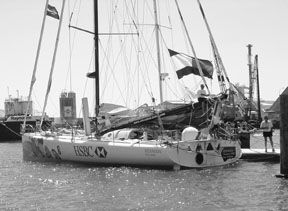The International Monohull Open Class consists of boats between 40 and 60 feet which are designed for shorthanded long-distance racing. The toughest event for this class is the Around Alone race, 29,000 miles of singlehanded racing following one of the classic round-the-world routes: North America to Europe, Europe to the Cape of Good Hope, Africa to Australasia, Australasia to South America, and back to North America. The legs are long and difficult, and feature every type of sailing, from tropical doldrums to the high-latitude hell of the extreme Southern Ocean. This is not a race for the faint of heart or weak of arm.

The traditional image of the singlehanded round-the-world racer is that of a wild-haired mad Frenchman with no concept of his mortality, surviving on a diet of cigarettes and red wine. The reality is far different. Yes, the archetype still exists, but Americans are working their way up the ladder in this type of racing, as are women. In fact, you hear as many North American and English accents among the Around Alone skippers as you do continental European. American, Canadian, Bermudian, English, and New Zealand flags are all seen on the sterns of Around Alone racers.
The America’s Cup is often touted as the cradle of high-tech development in sailing, but Open Class racing spawns and encourages many developments which will be seen on cruising boats of the future. Features such as can’ting keels, water ballast, and synthetic standing rigging are seen throughout the Open Class fleet. None of these characteristics is permitted in the more restrictive America’s Cup Class.
Because Open Class boats are designed for shorthanded and singlehanded racing on the open ocean, the problems they face are similar to those experienced by the normal couple on their 40-foot cruiser. Easy sailhandling, durability, reliable autopilots and electronics, weather routing, limited budgets, and avoiding collisions at sea are all part of shorthanded sailing, whether it’s racing or cruising.
Open Class programs rarely have the type of big budgets associated with more high-profile events such as the America’s Cup and the Volvo Ocean Race. Tighter budgets mean more imaginative use of resources—an idea familiar to any cruiser. The staggering sail development programs of America’s Cup syndicates, each of which spends millions on sails, are as foreign to the Open Class as they are to you and me.
Sailhandling hardware is primarily off-the-shelf. You’ll see exactly the same winches on these boats, for the most part, as you’ll find in your marine catalogs. Light weight may be important, but it takes a back seat to ruggedness.
Reliable autopilots are key to handling these boats. While the skippers hand-steer more than the average cruiser, they still need a trustworthy electric hand at the helm for a significant percentage of the time. Powerful, modern autopilots can steer as well as most helmsmen, freeing the skipper for sail trimming, weather analysis, navigation, route plotting, and rest.
These big headsails need reefers and furlers, just like any offshore cruiser. There is no loft full of sailmakers to fix damage at the end of the day, so bulletproof sails are the call.
The Open Class rule encourages developments in design and construction. Compared to a complex rule like the America’s Cup Class Rule, it is beautiful in its simplicity. The 60-foot class boats cannot exceed 60 feet in hull length. Total spar overhang, including bowsprit, cannot exceed six feet. Draft cannot exceed 14.76 feet. Canting keels and water ballast are permitted, but they cannot heel the boat more than 10 degrees from its upright position. Sail area is unlimited.
The boats must have crash bulkheads, watertight compartments, and escape hatches. They must have an angle of vanishing stability of at least 127.5 degrees, and must go through an extraordinary self-righting test to prove they can be brought upright after capsize.
Most importantly, the boats must have positive flotation, so that in the event of complete flooding, they will not sink. There are also the typical safety requirements necessary for any ocean racers, but compared to typical rating rules, the limits are few, and the opportunities to stretch the limits of design and construction are many.
These boats may look funny to the typical sailor, but they will, as much as any type of boat in the world, help shape the future of offshore sailboat design.
Also With This Article
Click here to view additional pictures.

































